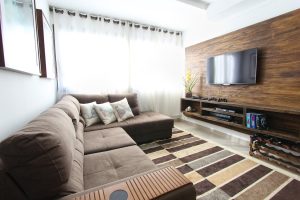When it comes to setting up your television, one of the most important factors to consider is the mounting height. The height at which your TV is mounted can have a significant impact on your viewing experience. Whether you are watching your favorite show, a movie, or playing video games, finding the right height for your TV is crucial for optimal comfort and enjoyment.
The importance of TV mounting height goes beyond just aesthetics. It directly affects the angle at which you view the screen, which in turn affects your overall viewing experience. Mounting your TV at the wrong height can result in discomfort, neck strain, and even back pain. Therefore, taking the time to find the optimal TV Mounting height is essential for creating a comfortable and enjoyable viewing experience.
Contents
- 1 The Science of Eye Level: Finding the Optimal TV Viewing Angle
- 2
- 3 Measuring Your Room: Factors to Consider Before Mounting Your TV
- 4 Wall-Mounting vs. Stand-Mounting: Which Option is Best for Your Space?
- 5 Additionally, you will need to consider cable management and hiding any unsightly wires.
- 6 Adjusting for Seating: Matching Your TV Height to Your Furniture
- 7 Mounting Above Fireplaces: Pros and Cons of This Popular Option
- 8 Additionally, mounting the TV above the fireplace allows for optimal viewing from various seating positions, as it is typically at eye level when seated.
- 9 Mounting in Bedrooms: Tips for Finding the Right Height for Your TV
- 10 Mounting in Home Theaters: How to Optimize Your Viewing Experience
- 11
- 12 This will provide an immersive viewing experience without straining your eyes.
- 13 DIY vs. Professional Installation: Which Route Should You Take?
- 14 Enjoying Your TV at the Perfect Height for Years to Come
Key Takeaways
- Mounting your TV at the right height is important for a comfortable viewing experience.
- The optimal TV viewing angle is at eye level, which can be determined by measuring your room and furniture.
- Wall-mounting and stand-mounting both have their pros and cons, so choose the option that works best for your space.
- Matching your TV height to your furniture is crucial for comfortable seating and viewing.
- Mounting above fireplaces and in bedrooms require special considerations, while home theaters require optimal placement for the best viewing experience.
The Science of Eye Level: Finding the Optimal TV Viewing Angle
When determining the optimal TV mounting height, it is important to consider the science of eye level. The ideal angle for comfortable viewing is typically at eye level or slightly below. This allows for a natural and relaxed viewing experience without straining your neck or back.
Mounting your TV too high can result in an uncomfortable viewing angle, as you will have to strain your neck to look up at the screen. On the other hand, mounting it too low can cause you to slouch or hunch over, leading to back pain and discomfort.
To find the optimal TV viewing angle, start by sitting in your usual viewing position and measure the height of your eyes from the floor. This measurement will serve as a guide when determining the ideal mounting height for your T
Measuring Your Room: Factors to Consider Before Mounting Your TV
| Factors to Consider | Description |
|---|---|
| Room Size | Determine the size of your room to ensure that your TV is mounted at an appropriate distance for optimal viewing experience. |
| Wall Material | Consider the type of wall material in your room to determine the appropriate mounting hardware needed for your TV. |
| Viewing Angle | Ensure that your TV is mounted at an appropriate height and angle to avoid neck strain and provide a comfortable viewing experience. |
| Lighting | Consider the lighting in your room to determine the best location for your TV to avoid glare and ensure optimal picture quality. |
| Cable Management | Plan for cable management to ensure that your TV setup looks neat and organized. |
Before deciding on the mounting height for your TV, there are several factors to consider based on the layout and size of your room. These factors include room size and layout, furniture placement and spacing, as well as lighting and glare.
The size and layout of your room will determine the optimal viewing distance and angle. For example, in a smaller room, you may need to mount your TV at a lower height to ensure comfortable viewing from all seating positions. In a larger room, you may need to consider the distance between the TV and seating area to avoid straining your eyes.
Furniture placement and spacing also play a role in determining the optimal TV mounting height. If you have a TV stand or entertainment center, you will need to consider the height of the furniture when determining the mounting height. Additionally, you should ensure that there is enough space between the TV and any surrounding furniture to avoid obstructed views.
Lastly, lighting and glare can impact your viewing experience. Consider the placement of windows and light sources in your room when determining the mounting height. You want to avoid any glare or reflections on the screen that can hinder your ability to see the content clearly.
Wall-Mounting vs. Stand-Mounting: Which Option is Best for Your Space?
When it comes to mounting your TV, you have two main options: wall-mounting or stand-mounting. Each option has its own benefits and drawbacks, and it is important to consider these factors when deciding which option is best for your space.
Wall-mounting your TV offers several advantages. It allows for a clean and streamlined look, as the TV is mounted directly on the wall without any additional furniture. This can be particularly beneficial in smaller spaces where floor space is limited. Wall-mounting also provides flexibility in terms of height adjustment, as you can easily move the TV up or down on the wall bracket.
However, wall-mounting does require some additional work and planning. You will need to ensure that you have a sturdy wall mount that can support the weight of your T
Additionally, you will need to consider cable management and hiding any unsightly wires.
Stand-mounting, on the other hand, offers its own set of advantages. It provides a stable and secure base for your TV, eliminating the need for wall mounting. Stand-mounting also allows for more flexibility in terms of TV placement, as you can easily move the TV around if needed.
However, stand-mounting can take up valuable floor space and may not be suitable for smaller rooms. It also limits your ability to adjust the height of the TV, as it is typically fixed to the height of the stand.
When choosing between wall-mounting and stand-mounting, consider factors such as room size, layout, and personal preference to determine which option is best for your space.
Adjusting for Seating: Matching Your TV Height to Your Furniture
In addition to considering the optimal TV mounting height based on eye level, it is also important to match the TV height to your furniture and seating position. This ensures that everyone in the room has a comfortable and unobstructed view of the screen.
The general rule of thumb is to have the center of the TV screen at eye level when seated. This means that if you have a sofa or chairs in your room, the TV should be mounted at a height that aligns with the eye level of someone sitting in those seats.
If you have multiple seating positions in your room, such as a combination of sofas and chairs, you may need to find a compromise when determining the mounting height. Consider the average eye level of all seating positions and aim to mount the TV at a height that provides a comfortable viewing angle for everyone.
Additionally, if you have reclining furniture or adjustable chairs, take into account the different positions people may be sitting in when determining the optimal TV mounting height. You want to ensure that no matter how someone is seated, they can still comfortably view the screen without straining their neck or back.
Mounting Above Fireplaces: Pros and Cons of This Popular Option
One popular option for TV mounting is above a fireplace. This setup offers a sleek and modern look, as well as the advantage of saving floor space. However, there are both benefits and drawbacks to consider when mounting your TV above a fireplace.
One of the main benefits of mounting a TV above a fireplace is the aesthetic appeal. It creates a focal point in the room and can be a great way to showcase your T
Additionally, mounting the TV above the fireplace allows for optimal viewing from various seating positions, as it is typically at eye level when seated.
However, there are some drawbacks to consider. One major concern is heat. Fireplaces generate heat, and excessive heat can damage your TV over time. It is important to ensure that there is enough space between the TV and the fireplace to prevent any heat-related issues.
Another concern is neck strain. Mounting the TV above eye level can result in an uncomfortable viewing angle, as you will have to look up at the screen. This can cause neck strain and discomfort, especially during extended viewing sessions.
To optimize your viewing experience when mounting your TV above a fireplace, consider using a tilting or articulating wall mount. This will allow you to adjust the angle of the TV to minimize neck strain and ensure comfortable viewing.
Mounting in Bedrooms: Tips for Finding the Right Height for Your TV
Mounting a TV in a bedroom requires careful consideration of various factors to ensure optimal comfort and enjoyment. The height at which you mount your TV in a bedroom can impact your overall viewing experience, as well as the aesthetics of the room.
When determining the optimal TV mounting height in a bedroom, consider factors such as bed height and seating position. The general rule of thumb is to have the center of the TV screen at eye level when seated on the bed. This ensures that you can comfortably view the screen without straining your neck or back.
If you have a TV stand or dresser in your bedroom, you will need to consider the height of the furniture when determining the mounting height. Aim to have the TV mounted at a height that aligns with the eye level of someone sitting on the bed or any other seating position in the room.
Additionally, consider the size of your bedroom and the distance between the TV and seating area. You want to ensure that the TV is not too far away or too close, as this can impact your ability to see the content clearly.
Mounting in Home Theaters: How to Optimize Your Viewing Experience
In a home theater setup, the placement of your TV is crucial for creating an immersive and enjoyable viewing experience. Whether you have a dedicated home theater room or a multi-purpose media room, there are several tips to consider when mounting your T
The first step is to determine the optimal viewing distance. This will depend on the size of your TV and the layout of your room. As a general rule, aim to sit at a distance that is approximately 1.5 to 2.5 times the diagonal screen size of your T
This will provide an immersive viewing experience without straining your eyes.
When it comes to mounting height, consider the seating position in your home theater. The center of the TV screen should be at eye level when seated in your preferred viewing position. This ensures that you can comfortably view the screen without straining your neck or back.
Additionally, consider factors such as room layout and acoustics when determining the optimal TV placement. You want to ensure that there are no obstructions or reflections that can impact your viewing experience. If you have surround sound speakers, make sure they are properly positioned for optimal audio quality.
DIY vs. Professional Installation: Which Route Should You Take?
When it comes to installing your TV, you have two main options: DIY installation or professional installation. Each option has its own benefits and drawbacks, and it is important to consider these factors when deciding which route to take.
DIY installation offers the advantage of cost savings. You can purchase a TV mount and install it yourself, eliminating the need for professional help. DIY installation also allows for flexibility and control over the process, as you can choose the exact mounting height and placement.
However, DIY installation does require some technical knowledge and skills. You will need to ensure that you have the necessary tools and equipment to properly install the TV mount. Additionally, you will need to consider factors such as wall type and stud placement to ensure a secure and stable installation.
Professional installation, on the other hand, offers the advantage of expertise and convenience. A professional installer will have the knowledge and experience to properly mount your TV at the optimal height. They will also have the necessary tools and equipment to ensure a secure and stable installation.
However, professional installation does come at a cost. Hiring a professional can be more expensive than DIY installation. Additionally, you may have less control over the exact mounting height and placement, as it will be determined by the installer based on their expertise.
When deciding between DIY and professional installation, consider factors such as your technical skills, budget, and personal preference. If you are confident in your abilities and have the necessary tools, DIY installation may be a suitable option. However, if you prefer the convenience and expertise of a professional, it may be worth investing in professional installation.
Enjoying Your TV at the Perfect Height for Years to Come
In conclusion, finding the right TV mounting height is crucial for creating a comfortable and enjoyable viewing experience. The optimal TV mounting height is typically at eye level or slightly below, ensuring a natural and relaxed viewing angle.
When determining the optimal TV mounting height, consider factors such as room size, layout, furniture placement, and seating position. Take into account the science of eye level and aim to have the center of the TV screen at eye level when seated.
Whether you choose to wall-mount or stand-mount your TV, ensure that it is mounted at a height that aligns with the eye level of someone sitting in the room. Consider factors such as furniture height, seating position, and room layout to determine the best mounting height for your space.
Lastly, consider whether DIY or professional installation is the right option for you. DIY installation offers cost savings and flexibility, while professional installation offers expertise and convenience. Choose the option that best suits your skills, budget, and personal preference.
By taking the time to find the optimal TV mounting height and considering all relevant factors, you can enjoy your TV at the perfect height for years to come. Create a comfortable and enjoyable viewing experience that allows you to fully immerse yourself in your favorite shows, movies, and games.
If you’re looking for the perfect TV mounting height, check out this helpful article from Utah TV Mounting. They provide a comprehensive TV mounting height guide that will ensure you get the optimal viewing experience in your home. Whether you’re mounting your TV in a historic home or at high altitudes, they have solutions to preserve the charm of your space while enjoying modern convenience. Don’t make common TV mounting mistakes – follow their expert tips and enhance your viewing experience. For more information, visit their blog for additional articles on TV mounting and home theater tips.




